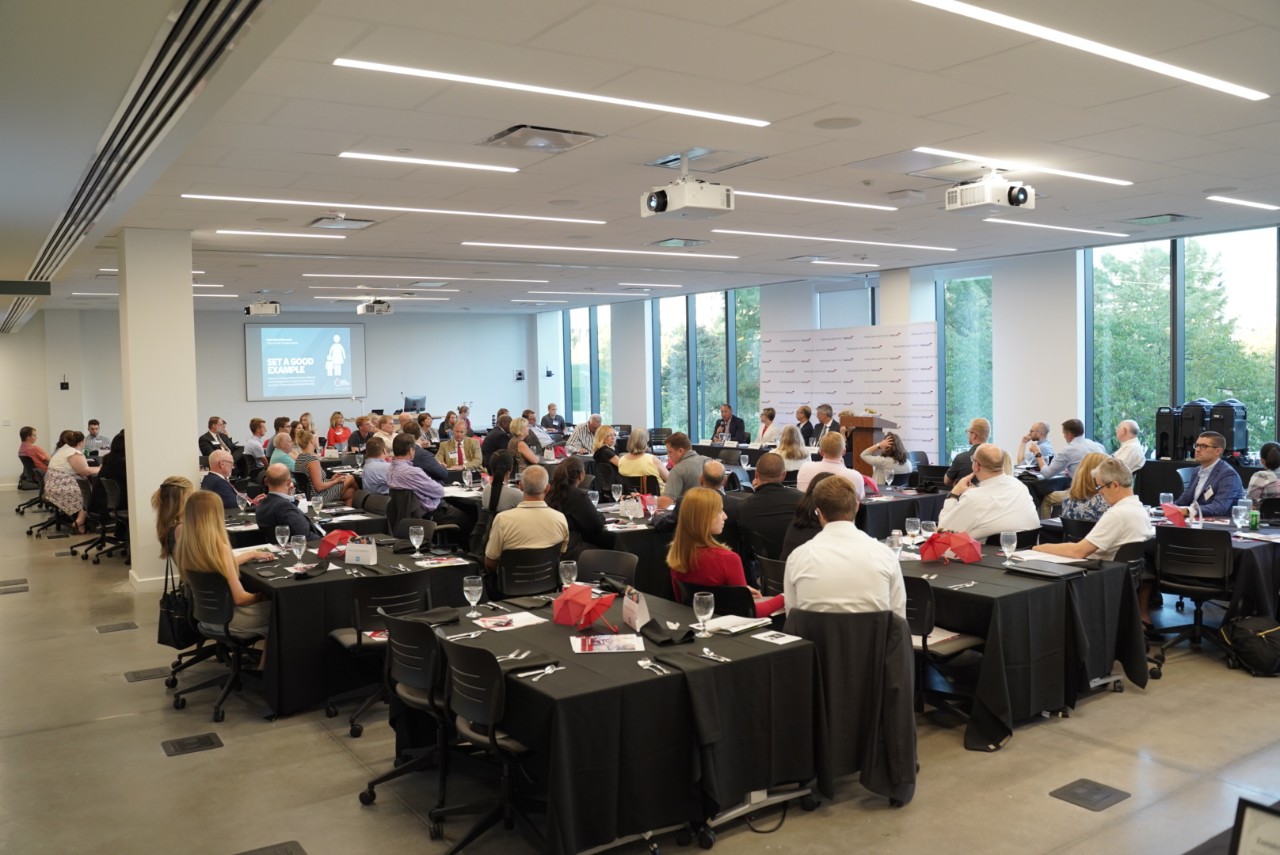
Lindner center hosts symposium on distracted driving
Panelists explore psychology, public policy, technology around distracted driving at Center for Insurance and Risk Management-hosted symposium at University of Cincinnati
When you’re driving a car, where is your cell phone? Out of sight tucked in a purse or bag, mounted near the dashboard as a directional aid, in your hand?
The Carl H. Lindner III Center for Insurance and Risk Management, along with Gamma Iota Sigma and the Travelers Institute, explored the sources and costs of distracted driving at the symposium, “Harnessing Psychology, Tech and Innovation to Combat Distracted Driving.”

Symposium panelists from left to right: Chris Hackworth, Michelle May, Peter Chiu, Ian Reagan and Joan Woodward./Photo courtesy Quinn Villarreal and Travelers Institute.
Held at the new Carl H. Lindner Hall on Wednesday, Oct. 2, the symposium featured panelists and presenters examining the behavioral insights, technological innovations, advances in auto safety, and personal and social pressures that may help combat distracted driving and save lives.
“Technology creates immense new opportunities, but it can also create new hazards,” said Steve Slezak, PhD, director of the Center for Insurance and Risk Management and professor-educator of finance. “This event explores how new technology – smart phones in particular — has increased the incidence and cost of distracted driving. Using insights from psychology, risk management and product innovation, we examine the possible social, legal and technological solutions that may reduce the toll of distracted driving on our roadways.”
Symposium panelists included:
- Peter Chiu, PhD, Associate Professor, Psychology and Communication Sciences and Disorders, University of Cincinnati College of Arts and Sciences
- Michelle May, Highway Safety Program Manager, Ohio Department of Transportation
- Dr. Ian Reagan, Senior Research Scientist, Insurance Institute for Highway Safety
- Chris Hackworth, Regional Vice President, Personal Insurance, Travelers
Technology creates immense new opportunities, but it can also create new hazards. We examine the possible social, legal and technological solutions that may reduce the toll of distracted driving on our roadways.
Steve Slezak, PhD Director of the Center for Insurance and Risk Management, Professor-Educator of Finance

A symposium attendee crafts a "do not disturb while driving" message on her smart phone./Photo courtesy Quinn Villarreal and Travelers Institute.
According to the Ohio Department of Transportation, Ohio experienced four consecutive years of rising traffic crashes and deaths between 2013 and 2017. Travelers recently commissioned a survey of 500 Cincinnati-area drivers in which 73 percent said they use their mobile device while driving, compared to the 68 percent of drivers across the country who admitted to the same behavior in the 2019 Travelers Risk Index.
Reasons drivers might use their mobile device while driving range from the fear of missing something important (20 percent) to being unable to resist the urge to check the phone (15 percent).
“Although a third of the drivers surveyed said that having access to communication-blocking technology would deter them from distracted driving, less than a quarter actually use it,” said Joan Woodward, president of the Travelers Institute and executive vice president of public policy at Travelers. “No one checks their phone with the intent of causing a crash, but it happens with alarming frequency. Education is key to changing attitudes and behaviors.”
Featured image: Nearly 75 attendees attended “Harnessing Psychology, Tech and Innovation to Combat Distracted Driving," a symposium exploring the sources and costs of distracted driving/Photo courtesy Quinn Villareal and Travelers Institute.
About the Carl H. Lindner III Center for Insurance and Risk Management
The Carl H. Lindner III Center for Insurance and Risk Management seeks to understand and improve how economies, enterprises and individuals manage risk. The center aims to be the premier provider of talent in the insurance and financial services industries as well as thought leadership through high-impact research and collaboration between academic and industry.
The Carl H. Lindner III Center for Insurance and Risk Management is supported by an endowment created by the generous gift made by Carl H. Lindner III and his wife, Martha, along with support from Great American Insurance Company, in memory of Carl H. Lindner Jr. Learn more about the center and the Insurance Risk Management (IRM) programs offered to help prepare students for a variety of careers in insurance and risk management.
About Travelers Institute
The Travelers Institute, the public policy division of The Travelers Companies, Inc., engages in discussion and analysis of public policy topics of importance to the insurance marketplace and to the financial services industry more broadly. The Every Second Matters initiative aims to change the social norms around distraction through educational programs for drivers, passengers and pedestrians.
Related Stories
What to know about this year’s big tax changes
January 2, 2026
Local 12 reported that taxpayers can expect some major changes this tax season. Gary Friedhoff, adjunct instructor at the University of Cincinnati’s Carl H. Lindner College of Business, recently spoke to Local 12 about how to avoid surprises.
Two UC-backed startups score $200K each from state
December 23, 2025
Innovative startup ventures TapIn and Saturn Sports rose from the UC Venture Lab to receive $200,000 each in funding through Ohio Third Frontier grants.
Challenges for veterans in the workforce
December 22, 2025
A new research review examines how veterans and their families impact the economy.
